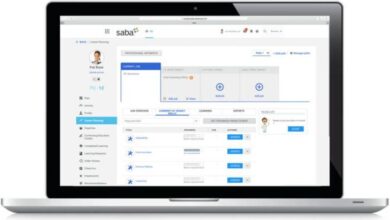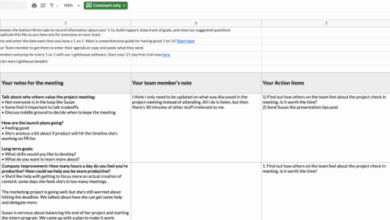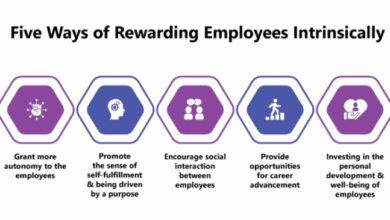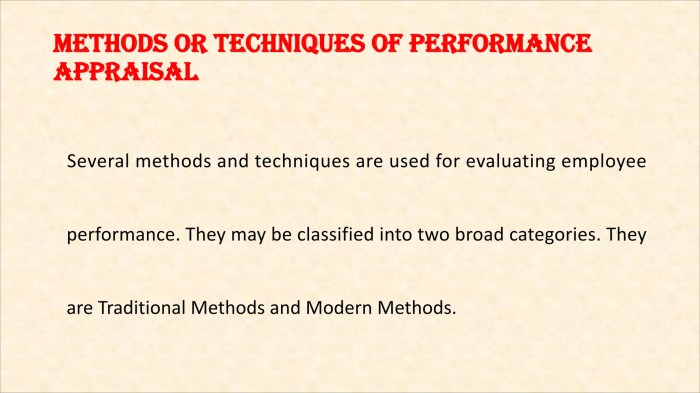
Types of performance appraisals are crucial for any successful organization. This guide delves into the various methods, from traditional trait-based assessments to modern 360-degree feedback. We’ll explore the strengths and weaknesses of each approach, helping you understand which system best fits your company’s needs and individual roles.
This in-depth look at performance appraisal types examines the evolution of these methods, from historical contexts to contemporary practices. It highlights the importance of choosing the right appraisal system for optimal employee development and organizational growth.
Introduction to Performance Appraisals
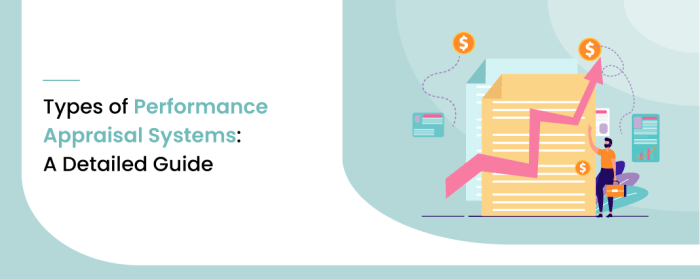
Performance appraisals are formal evaluations of an employee’s job performance over a specific period. They assess how well an employee meets the expectations of their role, highlighting strengths and areas needing improvement. These evaluations serve as a crucial tool for both employee and employer, fostering professional growth and organizational success.The primary purpose of performance appraisals is to provide constructive feedback, identify areas for development, and align individual performance with organizational goals.
They facilitate a structured dialogue between supervisors and employees, promoting a better understanding of expectations and responsibilities. Effective appraisals can lead to improved productivity, increased employee engagement, and a more efficient workplace.
Historical Context of Performance Appraisal Methods
Performance appraisal methods have evolved significantly over time, reflecting societal shifts in management philosophy and the growing importance of employee development. Early methods were often subjective and lacked a standardized framework. The evolution mirrors the broader progression of human resource management practices, from a focus on efficiency to a more nuanced understanding of employee needs and motivations.
Importance of Performance Appraisals in a Modern Workplace
In today’s dynamic and competitive environment, performance appraisals are more vital than ever. They are essential for driving employee engagement, promoting organizational growth, and fostering a culture of continuous improvement. Appraisals provide a platform for identifying skill gaps and training needs, enabling employees to develop their potential and contribute more effectively to the organization’s success. They also facilitate informed decision-making regarding promotions, compensation adjustments, and talent management strategies.
Comparison of Performance Appraisal Eras
| Era | Key Characteristics | Methods | Focus |
|---|---|---|---|
| Early 20th Century | Emphasis on efficiency and productivity. Limited focus on employee development. | Simple checklists, ranking systems. | Assessing output and adherence to procedures. |
| Mid-20th Century | Growing recognition of employee needs and motivation. Introduction of behavioral observation scales. | Graphic rating scales, behavioral checklists. | Evaluating performance based on observable behaviors and traits. |
| Late 20th Century to Present | Emphasis on goal setting, feedback, and continuous improvement. Integration of technology and data analytics. | 360-degree feedback, competency-based appraisals, performance management systems. | Developing employees’ skills, fostering teamwork, and aligning performance with organizational strategy. |
Different Types of Performance Appraisals
Performance appraisals are crucial for evaluating employee performance and fostering professional growth. Choosing the right appraisal method significantly impacts the effectiveness of the process. A well-structured appraisal system aligns with organizational goals, provides constructive feedback, and drives positive change.Different appraisal methods offer unique perspectives and strengths. Understanding the nuances of each approach is key to maximizing the benefits of the performance appraisal process for both employees and the organization.
Common Types of Performance Appraisals
Various methods exist for assessing employee performance. Understanding the strengths and weaknesses of each is essential for selecting the most suitable approach for a given context.
Performance appraisals come in various forms, from simple check-ins to more elaborate, multi-faceted reviews. This process, crucial for employee growth and company success, is sometimes surprisingly opaque. For example, consider the recent revelations of how sensitive intelligence gathering and strategic analysis were handled, as exposed by wikileaks splays stratfor wide open. Ultimately, understanding different appraisal methods is key to building a productive and transparent workplace environment.
- Trait-Based Appraisals: This method focuses on evaluating employees based on inherent traits like punctuality, communication skills, and work ethic. While seemingly straightforward, this approach can be subjective and may not reflect actual job performance. Potential biases can influence the ratings, and the lack of a direct link to specific job responsibilities may limit its effectiveness.
- Behavioral Appraisals: This method evaluates employee performance based on observable behaviors and actions. This approach is more objective than trait-based appraisals because it focuses on specific actions and their impact. Behavioral appraisals provide a framework for consistent and reliable evaluation, allowing for improved communication and feedback. The method’s effectiveness depends on the clarity of the behavioral indicators and the ability to define specific, observable behaviors.
- Results-Oriented Appraisals: This approach emphasizes the outcomes and achievements of employees. It focuses on quantifiable results, such as sales figures, project completion rates, and cost savings. This method is highly objective, aligning performance directly with organizational goals. However, it may not fully capture the contributions and efforts involved in achieving these results.
- 360-Degree Feedback Appraisals: This method gathers feedback from multiple sources, including supervisors, peers, subordinates, and even customers. This comprehensive approach provides a broader perspective on an employee’s performance. 360-degree feedback can identify blind spots and areas for improvement, leading to more holistic development. However, it requires careful design and management to avoid conflicting or inconsistent feedback.
Comparison of Appraisal Methods
Different appraisal methods offer distinct advantages and disadvantages. A careful analysis of these factors is crucial for selecting the appropriate method.
| Appraisal Type | Strengths | Weaknesses |
|---|---|---|
| Trait-Based | Simple to understand and implement | Subjective, prone to bias, not directly linked to job performance |
| Behavioral | Focuses on observable actions, more objective | Requires detailed behavioral descriptions, potentially time-consuming |
| Results-Oriented | Objective, directly linked to organizational goals | May not fully capture the efforts involved, potentially demotivating |
| 360-Degree Feedback | Holistic view, identifies blind spots, diverse perspectives | Complex to implement, requires careful coordination, potential for conflicting feedback |
Choosing the Right Appraisal Method
The selection of the most appropriate performance appraisal method depends on several factors. Organizational goals, employee roles, and the specific context need careful consideration. For instance, a sales team might benefit from a results-oriented approach, while a customer service team could gain valuable insights from a 360-degree feedback system.
Examples of Performance Appraisal Forms
The format of appraisal forms varies based on the chosen method. A trait-based form might use rating scales for different traits, while a results-oriented form would include specific metrics and targets.
A well-designed performance appraisal form should clearly define the criteria for evaluation, enabling both the evaluator and the employee to understand the expectations and the basis for the assessment.
For example, a behavioral appraisal form could include specific behavioral indicators with examples of how the employee demonstrated the behavior, allowing for more in-depth feedback and analysis.
Choosing the right performance appraisal method is crucial. Different approaches, like 360-degree feedback or behavioral assessments, exist. But before diving into the details of appraisal types, it’s essential to consider the 5 key questions to ask before a project launches, like those outlined in this insightful piece: 5 questions to ask it before a project kicks off.
This groundwork helps ensure the appraisal process aligns with project goals, ultimately leading to more effective performance evaluations overall.
Key Elements of Effective Performance Appraisals
Performance appraisals are crucial for employee development and organizational success. They provide a structured framework for evaluating employee contributions, identifying areas for improvement, and fostering a culture of continuous growth. A well-executed appraisal process goes beyond a simple review; it’s a powerful tool for aligning individual performance with overall organizational goals.Effective performance appraisals are built upon several key elements.
These elements ensure that the process is fair, transparent, and ultimately beneficial for both the employee and the organization.
Clear Performance Standards and Expectations
Establishing clear performance standards and expectations is paramount for a fair and productive appraisal. Vague or ambiguous criteria can lead to misunderstandings and subjective evaluations. Well-defined standards provide a common understanding of what constitutes satisfactory, good, and excellent performance. These standards should be documented and communicated effectively to employees in advance of the appraisal period. They act as a roadmap, guiding employees toward achieving desired outcomes.
By outlining specific, measurable, achievable, relevant, and time-bound (SMART) goals, organizations can effectively track progress and identify areas where support or additional training might be needed.
Regular Feedback
Regular feedback is essential for effective performance management. Providing feedback isn’t just a task for the appraisal meeting; it’s an ongoing process. Consistent, constructive feedback, both positive and corrective, helps employees understand their strengths and weaknesses. It allows them to adjust their approach and improve their performance. This approach fosters a culture of continuous improvement.
Constructive criticism, when delivered thoughtfully, can empower employees to learn and grow.
Goal Setting and Performance Planning
Goal setting and performance planning are integral components of the appraisal process. They involve collaboratively defining specific, measurable goals for the appraisal period. These goals should be aligned with the employee’s role and the organization’s objectives. This process empowers employees by giving them ownership of their development and allows them to contribute directly to the organization’s success.
Regular check-ins and progress reviews help ensure that the employee remains on track.
Linking Appraisals to Organizational Objectives
Effective performance appraisals directly connect individual performance to the overall organizational strategy. By aligning individual goals with company objectives, organizations can ensure that every employee’s contribution supports the larger vision. This alignment ensures that everyone is working towards the same targets and fosters a shared sense of purpose. For example, if a company aims to increase market share, performance appraisals can be designed to assess how individual roles contribute to this strategic objective.
Comprehensive Appraisal Process
A structured appraisal process streamlines the evaluation process and ensures fairness and consistency. A well-defined process ensures that the appraisal is a fair representation of an employee’s contributions. The process should be transparent and clearly defined to ensure both the manager and the employee understand the steps involved.
| Step | Description |
|---|---|
| 1. Planning | Establish performance standards and expectations. Set clear goals and objectives for the appraisal period. |
| 2. Performance Monitoring | Regularly track employee progress against established goals. Gather evidence of performance, both positive and negative. |
| 3. Feedback Discussions | Provide constructive feedback throughout the appraisal period. Schedule formal meetings to discuss performance and address any concerns. |
| 4. Appraisal Review | Evaluate the employee’s performance against pre-determined standards. Document observations and provide a comprehensive summary. |
| 5. Goal Setting for Next Period | Collaboratively set new goals and objectives for the upcoming period. Develop a plan for achieving those goals. |
Implementing Performance Appraisals
Putting a performance appraisal system into action requires careful planning and execution. A well-implemented system fosters a culture of continuous improvement, providing clear expectations, regular feedback, and opportunities for growth. It’s not just about evaluating past performance; it’s about setting the stage for future success.A successful performance appraisal system should be more than just a yearly review. It should be a dynamic process that involves ongoing communication, constructive feedback, and opportunities for employees to improve.
It’s crucial to make the process as transparent and fair as possible to build trust and maximize its effectiveness.
Steps in Implementing a Performance Appraisal System
Establishing a robust performance appraisal system involves several key steps. These steps should be clearly defined and communicated to ensure everyone understands their roles and responsibilities. The process should be consistently applied across the organization for fairness and equity.
- Establish Clear Performance Standards: Define specific, measurable, achievable, relevant, and time-bound (SMART) goals and expectations for each role. This provides a clear framework for evaluating performance. These standards should be communicated clearly to all employees.
- Training for Managers and Employees: Training is essential for successful implementation. Managers need training on how to conduct effective appraisals, provide constructive feedback, and address performance issues fairly. Employees should be trained on the appraisal process, how to set goals, and how to receive and respond to feedback.
- Regular Communication and Feedback: Ongoing communication is vital. Managers should provide regular feedback, not just during the appraisal period. This ongoing feedback loop fosters a supportive environment and allows for early intervention if needed.
- Establishing a Process for Addressing Performance Issues: A clear process for addressing performance issues is crucial. This process should be documented and communicated, ensuring fairness and consistency.
- Regular Review and Adjustments: The appraisal system should be reviewed and adjusted periodically to ensure it remains relevant and effective. Gathering feedback from employees and managers is essential to identify areas for improvement.
Training for Managers and Employees
Comprehensive training is essential for both managers and employees to ensure effective implementation of the appraisal system. This training should cover all aspects of the process.
- Manager Training: Training for managers should focus on conducting fair and constructive appraisals, providing specific and actionable feedback, and using the appraisal results to develop performance improvement plans.
- Employee Training: Employee training should focus on understanding the performance expectations, setting realistic goals, and receiving and responding to feedback constructively. It should also emphasize the importance of open communication.
Ongoing Communication and Support
Ongoing communication and support are critical for the success of the appraisal system. This is not just about the formal appraisal process but also about creating a culture of continuous improvement.
- Regular Feedback Sessions: Regular feedback sessions allow managers to provide guidance and support to employees. This can be informal check-ins or scheduled meetings.
- Employee Resources: Providing employees with access to resources such as mentors, training materials, or coaching can significantly enhance their performance.
Addressing Performance Issues Constructively
A well-designed appraisal system includes a process for addressing performance issues. This process should be handled with sensitivity and professionalism.
- Identifying Performance Gaps: Carefully identify the specific areas where performance is falling short. Document these issues with specific examples and dates. This is crucial for a fair and effective performance improvement plan.
- Open Communication: Have an open and honest conversation with the employee about the performance issues. Listen to their perspective and address their concerns.
Performance Improvement Plans
Performance improvement plans (PIPs) are formal documents outlining steps to address performance issues. They provide a clear path for improvement and should be tailored to the specific employee and issue.
- Clear Goals and Expectations: The PIP should clearly define the specific areas needing improvement, along with measurable goals and expectations. The goals should be achievable and realistic.
- Action Steps: Artikel specific steps the employee can take to improve performance. This could include training, mentorship, or additional support.
- Timeline: Set a realistic timeline for achieving the goals Artikeld in the PIP. Regular check-ins are crucial during this period.
Table of Performance Issues and Solutions
| Performance Issue | Possible Solutions |
|---|---|
| Poor Time Management | Training on time management techniques, adjusting workloads, setting realistic deadlines. |
| Lack of Communication Skills | Training on communication skills, providing feedback, encouraging active listening. |
| Lack of Motivation | Identifying the source of demotivation, offering incentives, providing opportunities for growth. |
| Poor Teamwork | Identifying specific issues, encouraging collaborative activities, providing team-building training. |
Legal and Ethical Considerations
Performance appraisals, while crucial for employee development and organizational success, must be conducted with meticulous attention to legal and ethical standards. Ignoring these aspects can lead to costly legal battles and damage the company’s reputation. Understanding the nuances of fairness, bias mitigation, and confidentiality is paramount for a robust and ethical appraisal process.Appraisals should be structured to avoid discriminatory practices and promote a level playing field for all employees.
This necessitates a thorough understanding of relevant employment laws and a commitment to upholding ethical principles throughout the appraisal process. Maintaining confidentiality and ensuring accuracy in documentation are vital for protecting both the company and the employees involved.
Performance appraisals come in various forms, from simple check-ins to comprehensive 360-degree reviews. It’s fascinating how these systems can sometimes be so detached from real-world issues like, say, the recent actions of LulzSec, specifically their latest “lark” targeting Arizona cops. lulzsecs latest lark targets ariz cops highlights the need for appraisals that go beyond the standard metrics and consider the broader context of employee behavior and ethical considerations.
Ultimately, the best appraisal methods are those that effectively gauge performance and encourage positive growth.
Legal Pitfalls to Avoid
Performance appraisals can present legal pitfalls if not conducted carefully. Failing to document performance issues properly, relying on subjective opinions without objective criteria, or using discriminatory factors in evaluations can expose the organization to legal challenges. It is critical to establish clear, measurable performance standards and ensure consistent application of those standards across all employees.
- Discrimination based on protected characteristics: Avoid basing performance evaluations on factors like race, religion, gender, age, or national origin. Instead, focus on job-related skills and accomplishments.
- Lack of documented performance issues: Thoroughly document performance problems and provide employees with opportunities to address them. This documentation is essential for justifying any disciplinary actions or performance improvement plans.
- Unclear performance standards: Establish precise and measurable performance standards. Vague or subjective criteria can lead to accusations of bias or unfair evaluation.
- Inconsistent application of standards: Ensure that performance standards are applied consistently across all employees. Favoritism or inconsistency can result in legal challenges.
Bias Mitigation Strategies
Biases, whether conscious or unconscious, can significantly influence performance appraisals. Recognizing and mitigating these biases is crucial for ensuring fair evaluations. Utilizing objective criteria, training managers on bias awareness, and employing multiple raters can help reduce the impact of bias.
- Objective criteria: Establish clear and measurable performance standards that are tied to specific job duties and responsibilities. These standards should be quantifiable whenever possible.
- Multiple raters: Involve multiple supervisors or peers in the appraisal process to gather diverse perspectives and reduce the impact of individual biases.
- Training on bias awareness: Provide training for managers on recognizing and mitigating potential biases. This can include workshops or online resources that highlight common biases and offer strategies for overcoming them.
- Regular performance feedback: Establish a system for ongoing feedback, allowing for a more continuous and holistic assessment of employee performance, rather than relying solely on annual appraisals.
Confidentiality in Performance Appraisals
Confidentiality is paramount in performance appraisals. Employee performance information should be treated with the utmost discretion, protecting sensitive data and maintaining trust. Sharing appraisal results with unauthorized individuals can damage employee morale and potentially lead to legal problems.
- Restrict access to appraisal information: Limit access to performance appraisal documents to authorized personnel only.
- Secure storage of documents: Implement secure storage procedures for all performance appraisal records.
- Employee privacy: Ensure that employee privacy is respected throughout the appraisal process.
- Avoid discussing appraisals outside the appropriate channels: Never discuss an employee’s performance evaluation with unauthorized individuals.
Summary of Legal and Ethical Guidelines
| Area | Guidelines |
|---|---|
| Bias Mitigation | Use objective criteria, multiple raters, and bias awareness training. |
| Documentation | Document performance issues thoroughly, ensuring clarity and consistency. |
| Fairness | Apply performance standards consistently and avoid discrimination. |
| Confidentiality | Maintain strict confidentiality of appraisal information. |
| Legal Compliance | Ensure compliance with all relevant employment laws and regulations. |
Performance Appraisal Tools and Technologies
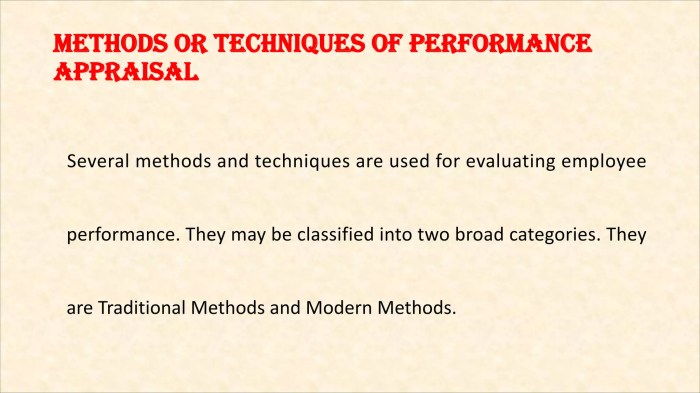
Performance appraisals are crucial for employee development and organizational success. However, traditional methods can be time-consuming and prone to bias. Fortunately, a variety of tools and technologies are transforming the performance appraisal process, making it more efficient, accurate, and insightful. These advancements enable organizations to collect and analyze data more effectively, leading to better employee engagement and improved overall performance.Modern tools streamline the appraisal process, providing a more objective and comprehensive evaluation of employee contributions.
By incorporating technology, companies can reduce the time spent on manual tasks, such as creating and reviewing forms, and instead focus on the more critical aspects of feedback and development.
Software Applications for Performance Management
Various software applications are available to streamline the performance management process. These applications often integrate with existing HR systems, providing a centralized platform for tracking employee performance, setting goals, providing feedback, and conducting reviews.
- Performance Management Software: Many specialized software solutions are designed specifically for performance management. These tools typically offer features for goal setting, performance tracking, feedback collection, and performance reviews. Examples include BambooHR, Zoho People, and 15Five.
- HR Information Systems (HRIS): Larger organizations frequently utilize HRIS systems that include performance management modules. These systems can be more comprehensive, incorporating functionalities such as employee self-assessments, manager feedback, and performance data analysis.
- Cloud-Based Platforms: Cloud-based platforms provide accessibility and flexibility. Employees can access performance information and complete required tasks from any location with an internet connection, facilitating remote work and global collaboration.
Streamlining the Appraisal Process with Technology, Types of performance appraisals
Technology can significantly streamline the appraisal process, saving time and resources. Automated workflows can reduce the administrative burden on HR and managers, enabling them to focus on the quality of the feedback and development plans. Data analysis features can identify trends and patterns in employee performance, allowing for more strategic interventions and targeted training initiatives.
- Automated Feedback Collection: Technology facilitates the collection of feedback, allowing for more consistent and timely reviews. This can include automated reminders for managers to provide feedback and systems that track the submission of feedback reports. This removes the burden of manual reminders and ensures that feedback is recorded.
- Performance Data Analysis: Performance management software often incorporates advanced data analysis capabilities. Organizations can utilize this to identify trends and patterns in employee performance, such as areas of strength and weakness, allowing for targeted interventions and development plans.
- Goal Setting and Tracking: Technology enables the establishment of clear goals and objectives, and tracking progress towards those goals. This facilitates transparency and accountability, motivating employees to achieve their targets. This technology often incorporates progress reporting features that give employees and managers real-time visibility into progress.
Benefits and Drawbacks of Technological Solutions
Technological solutions offer numerous advantages, but they also have potential drawbacks.
- Benefits: Increased efficiency, improved accuracy, enhanced communication, data-driven insights, and reduced administrative overhead are among the primary benefits. Technology enables organizations to track progress, analyze data, and identify areas for improvement more effectively.
- Drawbacks: The implementation of new technology can be expensive and require significant training for employees. Privacy concerns and data security issues also need to be addressed. Furthermore, over-reliance on technology may diminish the importance of human interaction in the appraisal process.
Comparative Analysis of Performance Appraisal Software
| Software Solution | Key Features | Pros | Cons |
|---|---|---|---|
| BambooHR | Performance reviews, goal setting, feedback tracking | Integrates with other HR functions, user-friendly interface | Limited advanced analytics, may not be suitable for large organizations |
| Zoho People | Performance reviews, goal setting, 360-degree feedback | Affordable pricing, customizable features | Steeper learning curve for some users, fewer integrations compared to BambooHR |
| 15Five | Focuses on continuous feedback, goal alignment | Promotes ongoing performance dialogue, aligns goals with company strategy | Can be less comprehensive for traditional performance review processes |
Performance Appraisal Results and Follow-up
Performance appraisals are more than just a one-time event; they’re a crucial part of ongoing employee development. Understanding the results, using them to improve performance, and providing constructive feedback are key to maximizing employee potential and organizational success. This section will delve into the critical steps involved in analyzing results, using data for improvement, and fostering continuous employee growth.Analyzing performance appraisal results is a multifaceted process that requires careful consideration of various factors.
It’s not simply about identifying strengths and weaknesses, but also about understanding the context surrounding those observations.
Analyzing Performance Appraisal Results
A comprehensive analysis goes beyond simply noting accomplishments and shortcomings. It involves examining the performance data in relation to established goals, benchmarks, and industry standards. Quantifiable metrics should be considered alongside qualitative observations. This approach helps provide a more balanced and accurate picture of performance.
Using Data to Improve Performance and Training
Performance appraisal data serves as a valuable resource for identifying areas where employees need further development. By analyzing trends and patterns, managers can identify recurring issues or skills gaps that require targeted training interventions. This proactive approach to development fosters a more skilled and productive workforce.
Providing Constructive Feedback and Performance Development Plans
Constructive feedback is a critical component of the performance appraisal process. It’s not about criticizing or blaming, but about offering specific and actionable suggestions for improvement. A performance development plan should be collaboratively developed, outlining clear steps for achieving specific goals and providing a roadmap for growth. This plan should be documented and reviewed periodically.
Importance of Follow-up and Ongoing Support
Ongoing support and follow-up are crucial to ensure the effectiveness of performance development plans. Regular check-ins allow for monitoring progress, providing additional guidance, and adjusting the plan as needed. This demonstrates a commitment to employee growth and fosters a positive work environment. Managers should be actively involved in these follow-up discussions.
Tracking Performance Improvements Over Time
Regular monitoring of progress is essential for ensuring that performance development plans are effective. A structured approach helps track progress over time.
| Employee | Performance Area | Initial Rating | Target Rating | Date of Follow-up | Progress Update | Next Steps |
|---|---|---|---|---|---|---|
| John Smith | Communication | 3 | 4 | 10/26/2024 | Improved clarity and tone in presentations. | Practice active listening skills. |
| Jane Doe | Problem Solving | 2 | 3 | 10/26/2024 | Demonstrated effective problem-solving skills in recent project. | Continue developing strategies for handling complex problems. |
This table provides a framework for tracking performance improvements over time. It allows for monitoring progress, identifying areas needing further attention, and adjusting the performance development plan accordingly. Regular updates and revisions ensure the plan remains relevant and effective in driving employee growth.
Final Wrap-Up: Types Of Performance Appraisals
In conclusion, selecting the appropriate performance appraisal method is a critical aspect of effective management. By understanding the different types, their strengths and weaknesses, and the crucial elements of an effective appraisal process, organizations can create a more productive and engaging work environment. This guide provides a robust framework for implementing a successful performance appraisal system.

